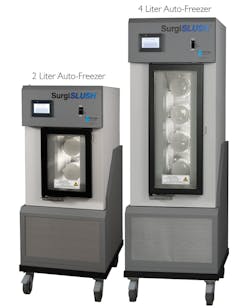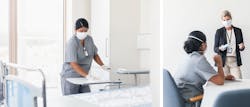Hospitals, operating rooms (ORs) and other healthcare providers remain committed to delivering the highest quality of care and safety for their patients as the COVID-19 pandemic presses on.
Last year, however, spending on medical care in the United States dipped, according to a news post from Altarum. “For the first year since at least 1960 – when the Centers for Medicare and Medicaid Services (CMS) began tracking national health expenditures – total health spending in 2020 was less than in the previous year. While spending has recovered somewhat from its pandemic-related decline in the spring, our preliminary estimate is that national health spending in 2020 was 2.0% lower than in 2019, a decline of about $75.8 billion dollars.”1
Altarum continued, “Among the major contributors to the decline were hospital care, the largest component, which was 7.0% lower in 2020 than in 2019, and dental services, which dropped 20.2% in 2020. These declines and those in other categories occurred as some services were temporarily curtailed and patients avoided seeking care to avoid exposure to the COVID-19 virus. At the same time, spending on prescription drugs and home health care actually increased for the year, the latter likely related to individuals selecting home care rather than nursing homes to avoid exposure.”1
Still, despite decreased spending and cases, hospitals and healthcare facilities have continued to make progress in care. Several, in fact, were awarded for their exceptional 2020 performance.
“The American Association of Critical-Care Nurses (AACN) recognized 208 units from 149 hospitals that earned the Beacon Awards for Excellence between Jan. 1, 2020, and Dec. 31, 2020…The award provides gold, silver and bronze levels of recognition to hospital units that exemplify excellence in professional practice, and patient care and outcomes.”2
Navigating challenges, needs
OR, surgical, and critical care teams confront many challenges with workloads, scheduling, personal protective equipment (PPE), device management and infection prevention (IP) during the continuing COVID-19 crisis.
Staff, scheduling shift
Tricia Coyle, MSN, RN, CPSN, Clinical Consultant, Gentherm, emphasized that, “One of the biggest challenges that affects all areas of the hospital is the continued strain on the clinical workforce. In addition to the increased risk of acquiring COVID-19, healthcare workers are experiencing longer working hours, fatigue, psychological stress and alterations to their work/life balance.”
Addressing the need for healthcare staffing, the American Hospital Association (AHA) wrote a letter to U.S. Congress members in support of the “Temporary Reciprocity to Ensure Access to Treatment (TREAT) Act.”
“The ongoing COVID-19 pandemic has brought unprecedented demands on the nation’s health care system, and it also has changed the way people receive care,”3 stated AHA. “As a result of the adoption of technology, the need to maintain social distance and stay-at-home, there has been a high demand for telehealth visits. During COVID-19 spikes in certain areas of the country, there has been a need for additional health care providers to arrive from out of state to provide much needed care…Your legislation allows for the temporary reciprocity for treatment by medical professionals licensed in one state to patients in other states. It is limited in duration to the COVID-19 pandemic and only allows a health care professional to practice within their licensed scope of practice.”3
“Regarding scheduling, COVID 19 presented a lot of challenges for our OR and procedural areas,” she said. “Government-mandated cancellation of all ‘non-urgent’ procedures halted surgical operations for almost two and a half months resulting in a loss of revenue and a large backfill once operations were able to resume. In the outpatient setting, the delivery of care to patients transitioned to a telemedicine model; this was challenging as some healthcare providers and patients are more technologically savvy than others.”
Equipment access
The flow and availability of medical tools and supplies have been main issues throughout the pandemic.
“From a manufacturer’s standpoint, I would say the biggest challenge is finding time to work with our customers on finding solutions,” expresses Christian Berling, Vice President, Sales and Marketing, HEINE USA Ltd. “They are all being pulled in so many directions that finding the time to catch up for a simple phone call is challenging. In the HEINE product line, we have seen demand for our reusable laryngoscopes and handles. Many customers who migrated to disposables in the past have experienced interruptions in deliveries that do not happen when you employ a reusable system.”
Mara Pare, Vice President, Client Solutions, PartsSource, adds, “Specifically, in the clinical engineering space, equipment uptime has been a major challenge. It is crucial for key equipment used for COVID patients, such as respiratory care equipment, to be kept operational for use with patients. When the equipment is down, clinical engineers are pushing as quickly as possible to source critical parts to service the equipment.”
Coyle stresses the demand for PPE and medical equipment.
“Our biggest needs have remained consistent throughout the pandemic – most commonly, N95 respirators, surgical gloves, gowns, testing supplies, and ventilators,” she noted. “In addition, a sustained pressure on the global supply chain causes delayed delivery of many items and persistent supply shortages. I don’t have specifics to all areas of the hospital, but delayed shipments of implants and/or essential OR materials (suture, disposable items, etc.) could and has an impact on patient care.”
Infection control
Caring for patients with COVID-19 disease creates additional risks for infections, indicates Eisenkraft.
“Unlike most cases of hospitalized complex patients, all COVID-19 patients pose a contamination threat to all those who are in close contact,” he explained. “It is not enough to keep the relevant precautions and follow strict workflows; several other tools and measures should be used in order to make sure the facility safety is kept, such as air exchange, PPE and training programs to the medical teams. This also includes looking at the team during their work, to search for early signs of exhaustion, which may lead to accidents, and in this specific case – accidents that may lead to contamination of the medical crew and their family members. An apparently simple handling of a ventilator becomes a challenge for preventing contaminated aerosol from being spread in the OR or in the intensive care unit.”
Eisenkraft additionally points to hazards of medical waste.
“A relatively neglected issue rarely discussed is the disposal of a large amount of waste,” he stated. “In this case, this is not the usual waste encountered in the OR and in the hospital in general, but biological waste, which should be handled carefully and under strict regulation.”
Elevating procedures, infection prevention
Moving forward through the COVID-19 crisis, hospitals and healthcare facilities look to the latest and most effective instruments, supplies, equipment, technology and practices to enhance surgical performance, patient outcomes and infection control.
What is out on the market now?
New tools, supplies and systems to support surgical procedures, patient monitoring, staff screening, medical device management, staff hand hygiene and environmental services (EVS) cleaning.
Surgical care
“Our customers benefit from our reusable laryngoscope system’s brighter light, savings of up to 50% compared to disposables and simple Joint Commission compliance,” expressed Berling.
Automated systems also may enhance patient procedures and protection.
A recent stride in cardiac care was at Penn State Heart and Vascular Institute where, “Richard Huggins, 75, of Lock Haven, PA, was the second patient in the nation to receive the EVAHEART2 Left Ventricular Assist System (LVAS),” according to a press release from Penn State Health News.”4
“Dr. Rob Dowling, director of heart device research at Penn State Heart and Vascular Institute and Penn State College of Medicine and one of the surgeons who implanted the pump, said the EVAHEART2…was designed to reduce the risk of post-implantation stroke, which affects approximately 8% of heart failure patients implanted with an LVAD,” 4 continued Penn State. “The procedure was part of the COMPETENCE Trial, a multi-center clinical study to evaluate EVAHEART2 that will include 40 clinical sites and 399 patients with severe heart failure through 2022.”
Patient, staff monitoring
“The Biobeat Technologies Ltd.’s end-to-end remote patient monitoring platform consists of small wearable wireless non-invasive sensors that automatically collect and transmit in real time 15 vital signs, including cuffless blood pressure, heart rate, respiratory rate, saturation, temperature, and advanced hemodynamic parameters,” Eisenkraft highlighted. “The platform is cloud-based, with no limits as to how many patients could be monitored at a given time. Deidentified patient data (the vitals only) is transmitted to a web application, available to the healthcare providers on any platform (laptops, tablets, etc.) and wherever they are.
He continued, “During the first COVID-19 wave, the Biobeat platform was deployed in most COVID-19 isolation units across Israel, and in several hospitals in the US, in Western Europe and in Africa. Direct contact with patients was cut in about a half, and healthcare providers received timely alerts helping them with situational awareness and as a decision support tool, with issues such as providing oxygen and ventilation…We were able to show that vast cardiological changes occur early upon admission among COVID-19 patients, at the same time respiratory changes appear. Remarkable changes were found in men compared to women, in the elderly and in the obese, and involved mainly the cardiac output and the systemic vascular resistance. In recent weeks, we also monitored people receiving the COVID-19 vaccines, with important insights regarding their side effects. In short, the vaccine looks safe, and we will soon publish our results.”
In terms of monitoring for infections, Coyle highlighted, “Within our institution, we were able to provide on-site COVID testing for patients and employees seven days a week. We also implemented a healthcare check tool, which was emailed to all employees each day. This questionnaire focused on signs and symptoms of COVID to assess if employees should report to work or quarantine and get tested.”
Device management
“We have worked with thousands of hospitals over the past year to help them obtain equipment replacement products as quickly as possible,” Pare stated. “For example, one hospital system’s clinical engineering department was challenged with a lack of oxygen hoses for ventilators, but through our nationwide network and using guaranteed stocking, the department was able to obtain those for the hospital overnight. For another hospital system, the Emergency Department and Pre-OP areas needed to order critical patient cables, but there was a three-week lead time with their usual vendor. By leveraging our command center, PartsSource can proactively isolate slowdowns in the supply chain and was able to have critical patient monitoring cables onsite within two to three days.”
Hygiene, cleaning protocols
“As a result of COVID-19, hand hygiene has been an increasingly prominent part of hygiene plans and the overall hygiene conversation, in and outside of hospital settings,” said Deborah Chung, Healthcare Segment Marketing Manager, Tork North America. “ Tork Interactive Clean Hospital Training (please note this training is web-based), enables EVS staff to train remotely in an engaging format and reduces the risk of introducing outside contaminants into operating rooms during these training sessions.”
Additionally, according to a Tork press release, “The training is based on the Association for the Health Care Environment’s (AHE) Practice Guidance for Health Care Environmental Cleaning…The training is available in more than 20 languages such as English, Spanish, Arabic, and Somali…Accompanying the Tork Interactive Clean Hospital Training is the ‘Train-the-Trainer’ presentation, a tool developed to help EVS leaders in training their teams.”5
Chung added, “Operating rooms and critical care environments demand an exceptional level of sterilization and cleanliness to prevent healthcare-associated infections (HAIs). To build out operating room surface cleaning protocols alongside educational trainings, operating room managers must also invest in surface cleaning products, such as the newly expanded range of Tork Microfiber Surface Cleaning Cloths, for their EVS teams, so that they can get the job done well and in a timely manner.”
Advancing tools, practices
What is on the horizon to cultivate efficient, effective and safe OR, surgical and critical care post-COVID-19?
“I think that the COVID-19 pandemic will shift the model of care provided. I think we will continue to utilize telehealth as much as possible. We will continue our current COVID-19 infection control protocols moving forward as it is now our ‘new normal.’”
Tricia Coyle, Gentherm
“The next couple of years, we still will probably be under the influence of the COVID-19 pandemic. As such, systems will have to learn how to live and work side by side with the pandemic. This includes keeping strict infection control measures, encouraging the completion of the vaccination campaign and, as soon as possible, investing in tools and technologies that will provide solutions to cope with the pandemic. Remote precision-robotic surgery seems to gain support and shows promise as more procedures are successfully performed. Remote patient monitoring will provide a solution for patients in the hospital and at home. It seems as if more countries are now ready to implement the idea of a hospital-at-home model, and with current available technologies – this concept is ready to be fully implemented.”
Arik Eisenkraft, Biobeat Technologies Ltd.
“Fighting the virus has only strengthened clinical focus on infection prevention. Going forward, medical devices that demonstrably deliver advantages toward those efforts will gain increased clinical adoption.”
Patrick Kammer, C Change Surgical
“We are hearing that the trend towards a reliance on disposables is reversing back to reusable products. The cost savings is dramatic, the quality and performance exceed disposable options and the facility is insulated from supply chain disruptions. All of this and the added benefit of being environmentally responsible is what is driving many facilities to shift back to reusable products where they make sense.”
Christian Berling, HEINE USA Ltd.
“COVID-19 has accelerated existing trends within healthcare technology management. In the short term, we expect hospitals to develop a more robust continuity plan and look more closely at their equipment lifecycle needs. We see them working with their vendors to take a quantitative look at their supply chain for not only equipment and parts, but service, accessories, supplies and preventative maintenance kits. As hospitals transition to a recovery phase, we expect to see further adoption of digital marketplaces and managed services platforms to increase supply chain reliability, increase technician productivity and decrease HTM/CE department costs. We also expect increased demand for additional on-site maintenance services that expand the HTM department’s capacity to tend to mission-critical equipment through in-house maintenance and specialized service partnerships.”
Mara Pare, PartsSource
“Hospitals and healthcare facilities will continue to see increased implementation of technology to streamline communication, employee needs and training to better establish consistent hygiene and surface cleaning protocols. Interactive training helps staff stay up to date with evolving hygiene best practices based on the current environment and ensures a uniform message is being delivered across the organization, so that EVS teams can meet the facility’s hygiene requirements. With a technology-driven approach, it’s easier to refresh training materials, strategies and tactics on a facility-wide basis and adapt to new and emerging methods of hygiene, such as surface cleaning. By investing in the right tools for EVS staff, it’s possible to provide a safe, supportive and hygienic environment for front-line staff and patients.”
Deborah Chung, Tork North America
2021 OR Buyers Guide Listings & Product Spotlights
References
1. Perspective: Did National Health Spending Decline in 2020 for the First Year in Recorded History? Preliminary Data Say it Did, FEBRUARY 16, 2021, George Miller, Corwin (Corey) Rhyan Ani Turner, https://altarum.org/news/did-national-health-spending-2020-decline-first-year-recorded-history-preliminary-data-say-it
2. In 2020, 208 Hospital Units Receive Beacon Awards, https://www.aacn.org/newsroom/in-2020-208-hospital-units-receive-beacon-awards
4. Hershey Medical Center second in the nation to implant next generation heart device, February 22, 2021, Penn State Health News, https://pennstatehealthnews.org/2021/02/hershey-medical-center-second-in-the-nation-to-implant-next-generation-heart-device/
5. Tork Introduces Interactive Clean Hospital Training and New Surface Cleaning Solutions, 02/25/2021, https://www.torkusa.com/about/pressroom/evsefficiency.aspx
About the Author

Ebony Smith
Ebony Smith was previously Managing Editor for Healthcare Purchasing News.







